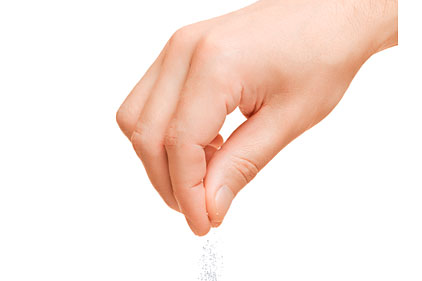Editor’s Note: This story originally published in Prepared Foods magazine, a sister publication of The National Provisioner. For more on this topic and other ingredients & formulation stories, visit PreparedFoods.com.
It seems manufacturers in virtually every food category are seeking a viable strategy to reduce sodium levels in their products. There have been a number of strategies applied to the task of reformulating products. However, success of the reduced-sodium foods is measured by consumers’ response to the new offerings.
Salt has a number of functions as a food additive. It is one of the most basic taste carriers and enhancers, and most consumers are highly attuned to that fact. It’s been established that simply making a product and leaving out half the sodium chloride results in a negative effect on the flavor of food. But, salt also has a marked effect on texture: Meat products are particularly affected by salt, as the binding capacity will be significantly reduced by the reduction in salt, leading to a decline in quality.
One of the major functions of salt in processed foods reaches back millennia: food safety and preservation. Salt is an important ingredient for the preservation of processed meats, especially cured meat products. And, as an antimicrobial, it’s been indispensible. To the point, reducing salt can affect the safety of a number of food products.
Yet, salt also has chemical functionality in the structure of certain formulations. For example, in bread baking, the reduction of salt will affect the gluten development necessary for it to rise evenly.
It contributes to the Maillard reaction responsible for the golden-brown crust on bread. Significant reduction of the salt content in bakery products will have a negative impact on their sensory properties.
The shape of things
Still, reducing salt for some processed products is inescapable. This means employing any of several methods: lowering the total sodium without altering any of the characteristics outlined above; lowering sodium by combining it with a certain percentage of other minerals; or replacing it altogether.
In many applications, the characteristic flavor profiles of salt can be attained with salt itself. There are two approaches to this: The first involves high purification and crystalline structure; and the second involves the crystalline structure, plus inherent natural qualities in an unrefined salt.
Purified sodium chloride, with subsequent altering of the shape of the crystal, can allow for a faster dissolving time that allows a more potent kick of salt on the tongue—with less of the mineral. Some manufacturers of purified sodium chloride have created lower-density flakes with greater surface area, for a faster melt that delivers the same intensity and flavor as a standard crystal, but with 33% less sodium chloride. These sodium-reduction systems can be used as one-to-one replacements for sodium chloride that allow processors to cut up to half the salt from a recipe.
Also, even in these lower amounts, the flakes still work to help control microbial activity, and when combined with other tools, are nearly as effective as salt.
Unrefined, natural sea salts contain other minerals and trace elements that are inherent to the solar-dried ocean water from which they are derived. Although to be sold as food, salt must be at least 97% pure, the content of these minerals is typically low, yet they can add subtle shifts in flavor perception.
When binding to the taste receptors in conjunction with the sodium chloride, those added minerals—such as magnesium, calcium, copper, iron and upwards of dozens of others—add different dimensions to the overall flavor composition of the recipe. Crystals form of their own accord, within concentration ponds and with the help of sun and wind. They also include a variety of shapes, including hollow pyramids and paper-thin flakes, and can alter the perception of salt on the tongue and favorably impact the flavor and intensity of the salt on the palate.
Another trend combines the unique shapes and chemical make-up of an unrefined sea salt with herbs or other flavors, including smoking the salt or processing it with different botanical flavorants or spices. They also add fragrance, which stimulates flavor perception in more simple applications.
Last year, the study, “Comparison of Salty Taste and Time Intensity of Sea and Land Salts from Around the World,” published by Drake & Drake in the Journal of Sensory Studies, helped support this. A trained, descriptive sensory panel evaluated 38 sea salts for flavor and time-intensity. The results showed a wide range of sensory response when tested at equivalent concentrations. The salty taste at an equivalent sodium concentration was not different (P<0.05). However, the time-intensity profiles were significantly different. Some of the sea salts had other flavors, like herbal, smoky and earthy. It was concluded that the sea salts with larger and faster time-intensity curves for saltiness may be used at significantly lower concentrations—as much as 30% less or greater.
“Small” is not necessarily a shape, but ingredient makers have been experimenting with the effects of crystal size on flavor perception. Ultra-small crystals manufactured via a proprietary technique referred to as micropulverizing leaves salt with three times more surface area per unit weight than traditional salt crystal size. In one test, potato chips made using a micropulverized salt allowed 20% less sodium in the final chip product, without significant difference in consumer preference.
Can’t use the real deal
Salt substitutes have been around for the last 50 years. The most popular replacement has been potassium chloride (KCl). In many products where saltiness is used as an add-on or a condiment, KCl works quite well. However, for some products, this “salt sister” is not always an ideal 1:1 trade-out. Sensory studies have consistently noted that levels of KCl that approach the saltiness of sodium chloride tend to deliver bitterness or a metallic note. Direct replacement with KCl has proven to be a poor solution, from the point of view of the average consumer. Because of this, blends of potassium with sodium chloride have become a common option.
Along with KCl and NaCl, tertiary minerals, such as calcium and/or magnesium, are sometimes included to balance out any possible off-notes. Alternatively, compounds such as choline chloride, potassium lactate or potassium diacetate might suit. Also in use are blends containing tri-potassium citrate, potassium gluconate and potassium lactate. Phosphates are commonly used in processed meat products to extract protein and help with water-binding, as noted in the July 2012, report, “Evaluation of Technological Approaches to Salt Reduction,” by Leatherhead Food Research Ltd.
“Even though sodium phosphates contribute to the overall sodium content of the product, they can allow a reduction in the amount of sodium chloride needed for protein functionality and, therefore, reduce the overall sodium content in the product. In addition, potassium phosphates can be used instead of sodium phosphates. There are maximum legal usage limits for phosphates and these need to be adhered to,” explained the report’s authors.
A number of non-mineral flavorings have been employed to reduce the amount of sodium in a salt-lowering or flavor-enhancing system. These can include yeast extracts, hydrolyzed vegetable proteins (HVP), monosodium glutamate (MSG) and other glutamic acids. HVP ingredient systems have a long history as flavor enhancers in meat-based and similar products, including soups, gravies, sauces and stews. But, these systems typically have high levels of naturally occurring sodium. New technology, however, has been able to bring HVPs to the sodium-reduction playing field. Chemists have managed to create HVPs with sodium levels low enough to allow them to drop final-product sodium levels by 25% or greater.
For MSG, consumer hesitance can be high. A recent approach to addressing this resistance has included use of concentrates of vegetables, such as onions, mushrooms and tomatoes. One newly popular flavor-enhancement ingredient is derived from concentrated extracts of tomato oleoresins. These have proven ideal for formulations such as soups and sauces. Development has allowed these to be manufactured in systems that can be used in liquid or powder formulations. They typically are highly stable and able to withstand the high temperatures and variable pH levels of soup and sauce production.
Another option for MSG relies on fermented grain portions. The use of a fermented wheat protein, in combination with maltodextrin and sodium chloride, can be used in meat, poultry, seafood, soups, sauces, dressings and marinades—or in dry mixes, such as rubs and seasoning blends—to replace HVP or MSG. This also allows a “100% natural” claim or a clean label. Similar products with fermented soy—essentially powdered, lighter versions of soy sauce, with 30% lower sodium—also allow similar application.




Report Abusive Comment